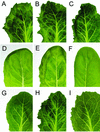The eukaryotic translation initiation factor 4E controls lettuce susceptibility to the Potyvirus Lettuce mosaic virus
- PMID: 12857809
- PMCID: PMC167067
- DOI: 10.1104/pp.102.017855
The eukaryotic translation initiation factor 4E controls lettuce susceptibility to the Potyvirus Lettuce mosaic virus
Abstract
The eIF4E and eIF(iso)4E cDNAs from several genotypes of lettuce (Lactuca sativa) that are susceptible, tolerant, or resistant to infection by Lettuce mosaic virus (LMV; genus Potyvirus) were cloned and sequenced. Although Ls-eIF(iso)4E was monomorphic in sequence, three types of Ls-eIF4E differed by point sequence variations, and a short in-frame deletion in one of them. The amino acid variations specific to Ls-eIF4E(1) and Ls-eIF4E(2) were predicted to be located near the cap recognition pocket in a homology-based tridimensional protein model. In 19 lettuce genotypes, including two near-isogenic pairs, there was a strict correlation between these three allelic types and the presence or absence of the recessive LMV resistance genes mo1(1) and mo1(2). Ls-eIF4E(1) and mo1(1) cosegregated in the progeny of two separate crosses between susceptible genotypes and an mo1(1) genotype. Finally, transient ectopic expression of Ls-eIF4E restored systemic accumulation of a green fluorescent protein-tagged LMV in LMV-resistant mo1(2) plants and a recombinant LMV expressing Ls-eIF4E degrees from its genome, but not Ls-eIF4E(1) or Ls-eIF(iso)4E, accumulated and produced symptoms in mo1(1) or mo1(2) genotypes. Therefore, sequence correlation, tight genetic linkage, and functional complementation strongly suggest that eIF4E plays a role in the LMV cycle in lettuce and that mo1(1) and mo1(2) are alleles coding for forms of eIF4E unable or less effective to fulfill this role. More generally, the isoforms of eIF4E appear to be host factors involved in the cycle of potyviruses in plants, probably through a general mechanism yet to be clarified.
Figures





Similar articles
-
Mutational analysis of plant cap-binding protein eIF4E reveals key amino acids involved in biochemical functions and potyvirus infection.J Virol. 2008 Aug;82(15):7601-12. doi: 10.1128/JVI.00209-08. Epub 2008 May 14. J Virol. 2008. PMID: 18480444 Free PMC article.
-
The C terminus of lettuce mosaic potyvirus cylindrical inclusion helicase interacts with the viral VPg and with lettuce translation eukaryotic initiation factor 4E.J Gen Virol. 2012 Jan;93(Pt 1):184-193. doi: 10.1099/vir.0.035881-0. Epub 2011 Sep 14. J Gen Virol. 2012. PMID: 21918009
-
Key mutations in the cylindrical inclusion involved in lettuce mosaic virus adaptation to eIF4E-mediated resistance in lettuce.Mol Plant Microbe Interact. 2014 Sep;27(9):1014-24. doi: 10.1094/MPMI-04-14-0111-R. Mol Plant Microbe Interact. 2014. PMID: 25105805
-
Recessive resistance to plant viruses.Adv Virus Res. 2009;75:119-59. doi: 10.1016/S0065-3527(09)07504-6. Epub 2010 Jan 13. Adv Virus Res. 2009. PMID: 20109665 Review.
-
[Recessive resistance to plant viruses by the deficiency of eukaryotic translation initiation factor genes.].Uirusu. 2020;70(1):61-68. doi: 10.2222/jsv.70.61. Uirusu. 2020. PMID: 33967115 Review. Japanese.
Cited by
-
Melon RNA interference (RNAi) lines silenced for Cm-eIF4E show broad virus resistance.Mol Plant Pathol. 2012 Sep;13(7):755-63. doi: 10.1111/j.1364-3703.2012.00785.x. Epub 2012 Feb 6. Mol Plant Pathol. 2012. PMID: 22309030 Free PMC article.
-
Engineering of CRISPR/Cas9-mediated potyvirus resistance in transgene-free Arabidopsis plants.Mol Plant Pathol. 2016 Oct;17(8):1276-88. doi: 10.1111/mpp.12417. Epub 2016 Jun 27. Mol Plant Pathol. 2016. PMID: 27103354 Free PMC article.
-
Loss of susceptibility as a novel breeding strategy for durable and broad-spectrum resistance.Mol Breed. 2010 Jan;25(1):1-12. doi: 10.1007/s11032-009-9323-6. Epub 2009 Aug 15. Mol Breed. 2010. PMID: 20234841 Free PMC article.
-
EcoTILLING in Capsicum species: searching for new virus resistances.BMC Genomics. 2010 Nov 12;11:631. doi: 10.1186/1471-2164-11-631. BMC Genomics. 2010. PMID: 21073716 Free PMC article.
-
Intrinsic disorder in Viral Proteins Genome-Linked: experimental and predictive analyses.Virol J. 2009 Feb 16;6:23. doi: 10.1186/1743-422X-6-23. Virol J. 2009. PMID: 19220875 Free PMC article.
References
-
- Altschul SF, Gish W, Miller W, Myers EW, Lipman DJ (1990) Basic local alignment search tool. J Mol Biol 215: 403–410 - PubMed
-
- Aranda M, Maule AJ (1998) Virus-induced host gene shutoff in animals and plants. Virology 243: 261–267 - PubMed
-
- Bates PA, Kelley LA, MacCallum RM, Sternberg MJ (2001) Enhancement of protein modeling by human intervention in applying the automatic programs 3D-JIGSAW and 3D-PSSM. Proteins Suppl 5: 39–46 - PubMed
-
- Bechtold N, Ellis J, Pelletier G (1993) In planta Agrobacterium mediated gene transfer by infiltration of adult Arabidopsis thaliana plants. C R Acad Sci Ser III Sci Vie 316: 1194–1199
Publication types
MeSH terms
Substances
LinkOut - more resources
Full Text Sources
Other Literature Sources
Miscellaneous

